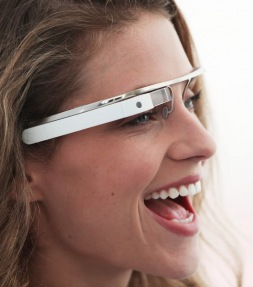
Future Fragments: Google Goggles and Iron Man’s Helmet
Written by: Anastasia Salter, Pop-Culture Editor
 In Terminator 2, a newly arrived from the future Arnold sizes up a bunch of punks with his artificial vision. The assessment of the measurements of each guy to find a perfect clothing fit is not so different from Kinect’s estimation of the length of our limbs in designing gesture-based interfaces for us to work with or deciding whether we’re cutting it on our yoga routine. The technologies to accomplish some of the awesomeness of augmented vision (without the need for going fully-on AI or cyborg, at least yet) are hurtling towards us, with Google slowly leaking information about their in-progress glasses and Iron Man taunting us with his fully augmented helmet, complete with status bars and power warnings. Are we ready for taking a virtual lens to our world? What will that “augmented” reality look like?
In Terminator 2, a newly arrived from the future Arnold sizes up a bunch of punks with his artificial vision. The assessment of the measurements of each guy to find a perfect clothing fit is not so different from Kinect’s estimation of the length of our limbs in designing gesture-based interfaces for us to work with or deciding whether we’re cutting it on our yoga routine. The technologies to accomplish some of the awesomeness of augmented vision (without the need for going fully-on AI or cyborg, at least yet) are hurtling towards us, with Google slowly leaking information about their in-progress glasses and Iron Man taunting us with his fully augmented helmet, complete with status bars and power warnings. Are we ready for taking a virtual lens to our world? What will that “augmented” reality look like?
These are only the beginnings of what science fiction has imagined in augmented vision—in Charles Stross’s Halting State, the police scan the streets with visuals that mark past crimes and incidents at every home and street corner, while back in the real world police are starting to scan faces with the help of new technology. Other types of scanning are less threatening and a bit more social, with smartphones offering tools for finding local singles that could someday translate into a visual version of Facebook or okCupid projecting statuses, social networks or compatibility scores over fellow bar patrons and passers-by.
In some ways, visual enhancement has been around a long time. But with binoculars, telescopes or even night-vision goggles, devices were taking what was already visible (at some level) and making it moreso, by enhancing human vision well beyond its previous potential. Devices like Google’s glasses (forever doomed to be referred to as Google Goggles), or some future implant version of the terminator’s analytic screen, can do more than that: they can make the invisible visible.
There are plenty of things that could go wrong with this, like walking into a pole—or in front of a train—while trying to read a Google map or the inevitable hacking of the glasses to cover one’s vision in porn ads and pop-up boxes. But this vision of a future–where instead of staring at screens, we stare at our world through a screen as lens–doesn’t seem so distant.
I for one was disappointed when Google Drive was announced and turned out to be yet another cloud storage solution instead of those automated vehicles we’ve all been waiting for. Perhaps in leading a movement towards augmented reality as a hands-free experience integrated with the whole world around us Google can redeem themselves for that disappointment. (Of course, these glasses would still be cooler if you were a passenger in an automatic car…and I predict tons of disclaimers about wearing them while operating a vehicle.)
Right now, glasses with built in directions, mail-checking, movie-watching, and Twitter-feed checking features sound pretty geeky, but geeky is in. And if Terminator told us anything it’s that people in the right shades can make any tech enhancement that much cooler. Just look at iPad cases by top designers—if this takes off, is a Chanel version of AR glasses far behind?
But while we all imagine a future where a sheet of glass between us and the world might make it interpretable and layered with meaning in the many ways science fiction has foretold, it’s worth remembering another classic: Luke Skywalker’s triumph over the death star. After he switched off his automated targeting system, he saw—and sensed—the world for what it is. It doesn’t take a tech alarmist to wonder what the consequences of continual virtualization might be. Why repaint or improve a neighborhood when you can just walk around in filtered glasses? It worked for The Wizard of Oz’s Emerald City. And if such augmented systems do create meaning, will they become a crutch or even a replacement for discernment?
Perhaps not—perhaps they will reveal a depth that is otherwise not observable, just as telescopes showed us what was previously only imagined. But it’s probably going to be a while before these technologies give us the detail-oriented data reading of Sherlock Holmes (ala the modern BBC version, of course) or spot our future partner in a crowded Times Square.
Until then, these next devices should give sci-fi plenty new to build on.
